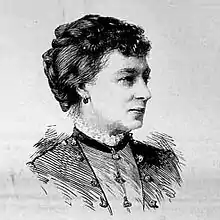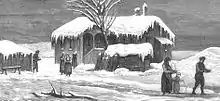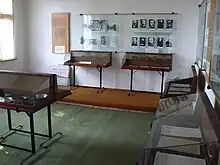Lady Strangford
Lady Strangford, Emily Ann Smythe or Emily Anne Beaufort RRC, (1826 – 24 March 1887) was a British illustrator, writer and nurse. There are streets named after her and permanent museum exhibits about her in Bulgaria. She established hospitals and mills to assist the Bulgarians following the April Uprising in 1876 that preceded the re-establishment of Bulgaria. She was awarded the Royal Red Cross medal by Queen Victoria for establishing another hospital in Cairo.
Lady Strangford | |
|---|---|
 from The Graphic | |
| Born | Emily Anne Beaufort 1826 |
| Died | 24 March 1887 SS Lusitania in the Mediterranean |
| Nationality | British |
| Other names | Emily Ann Smythe |
| Known for | Travel writing and war nursing |
| Spouse | Percy Smythe, 8th Viscount Strangford |
Life
Emily Anne Beaufort was born in St Marylebone and baptised in April 1826. Her parents were Admiral Sir Francis Beaufort and his wife Alice. Her father gave his name to the Beaufort Scale.[1]
In 1858 she set out on a journey with her elder sister to Egypt.[2] The book that she wrote, Egyptian Sepulchres and Syrian Shrines was dedicated to her sister, and describes the places she visited in Syria, Lebanon, Asia Minor and Egypt with illustrations based on her sketches from her journey. The volume was so popular that it was re-issued several times.[3]
Of the ancient oasis city, Palmyra she writes:
"I was once asked whether Palmyra was "not a broken-down old thing in a style of slovenly decadence?" It is true its style is neither pure nor severe: nothing over which the lavish hand of hasty and Imperial Rome has passed is ever so: but, Tadmor [Palmyra] is free from all the vulgarity of real decadence; it is so entirely irregular as to be sometimes fantastic; the designs are overflowing with richness and fancy, but it is never heavy: it is free, independent, bizarre, but never ungraceful; grand indeed, though hardly sublime, it is almost always bewitchingly beautiful." (pp. 239–40)[4]

Strangford received a critical review of her 1861 book Egyptian Sepulchres and Syrian Shrines by Percy Smythe, later Viscount Strangford.[5] Unusually, this led to them meeting and their marriage.[2]
In 1859 and 1860 she was travelling in Smyrna, Rhodes, Mersin, Tripoli, Beirut, Baalbek, Athens, Attica, the Pentelicus mountains, Constantinople and Belgrade. During the whole journey she kept a journal recording all that she experienced.[6]
When Strangford published her second book Eastern Shores of the Adriatic in 1864[7] it had a final anonymous chapter title "Chaos," which is attributed to her husband, Percy Smythe, 8th Viscount Strangford. This work is considered important in his writing career. Her husband was twice president of the Royal Asiatic Society in the 1860s. He died in 1869 and as they had no children his titles became extinct.
Widow and nurse
Following her husband's death Strangford volunteered to serve as a nurse in (probably) University College Hospital in London. In 1874 her studies led her to advocate a change in the way that nurses were trained. She published Hospital Training for Ladies: an Appeal to the Hospital Boards in England. She advocated that nurses should be allowed to train and work part-time. She believed that the training to be a nurse would benefit many women in their role within a family. This idea did not gain official backing as the major objective at the time was to establish nursing as a profession and not as a part-time activity for amateurs.[2]

The war crimes that were taking place in Bulgaria in 1876 gained her attention.[8] Christians had suffered massacres by the Ottomans and Strangford initially joined one committee and then she set up her own.[9] Thousands of pounds were raised by the Bulgarian Peasants Relief Fund and she went to Bulgaria in 1876 with Robert Jasper More, eight doctors and eight nurses.[2] Both she and More wrote letters to The Times to report and gather more funds.[8] Strangford believed that the Bulgarians and not the Serbs would be important as the Ottoman Empire shrank. These were views that she had shared with her husband. Strangford found the Bulgarians to just need the tools for their own self-improvement and she was impressed that their first priority was a school.[10] She built a hospital at Batak and eventually other hospitals were built at Radilovo, Panagiurishte, Perushtitsa, Petrich and at Karlovo.[11][12] She also provided subsidies to a flour mill and a number of saw mills.[2]
In 1883 Queen Victoria awarded her the Royal Red Cross for creating, with Dr Herbert Sieveking the Victoria Hospital, Cairo.[2] The hospital continued in operation thanks to a grant of £2,000 per year from the Egyptian government taking in local students for training and offering first class accommodation on a private basis.[13]
Strangford edited A Selection from the Writings of Viscount Strangford on Political, Geographical and Social Subjects which she published in 1869[14] and Original Letters and Papers upon Philology and Kindred Subjects in 1878.[15] She also published her brother-in-law's novel Angela Pisani after his death and she helped found the Women's Emigration Society with Caroline Blanchard which arranged for British women to find jobs abroad.[2]
In her later years, Lady Strangford had a London home at 3 Upper Brook Street, Mayfair.[16] She died on board SS Lusitania of a stroke in 1887. She was travelling through the Mediterranean en route for Port Said where she was to create a hospital for seamen. Her body was returned to London and buried in Kensal Green Cemetery.[2]
Legacy

Strangford is best remembered in Bulgaria where a number of memorials and streets are named in her honour. Plovdiv Regional Historical Museum has a permanent display about Lady Strangford.[17]
In Sofia's Museum of Natural history, there is a herbarium created by Strangford.[18]
References
- "Beaufort - National Meteorological Library and Archive Fact sheet 6 — The Beaufort Scale" (PDF). Met Office. 2 October 2012. Archived from the original (PDF) on 2 October 2012. Retrieved 9 April 2021.
- Elizabeth Baigent, 'Strangford , Emily Anne, Viscountess Strangford (bap. 1826, d. 1887)', Oxford Dictionary of National Biography, Oxford University Press, 2004 accessed 2 May 2015
- Viscountess Strangford Archived 24 February 2017 at the Wayback Machine, University of Wales, retrieved 3 May 2015
- Frances Terpak and Peter Louis Bonfitto. "19th-Century Travel". The Legacy of Ancient Palmyra. The Getty Research Institute. Retrieved 10 February 2017.
- One or more of the preceding sentences incorporates text from a publication now in the public domain: Chisholm, Hugh, ed. (1911). "Strangford, Viscount s.v. Percy Ellen Frederick William Sydney Smythe". Encyclopædia Britannica. Vol. 25 (11th ed.). Cambridge University Press. p. 983.
- Viscountess Emily Anne Beaufort Smyth Strangford Journal, 1859-1860, Duke University, retrieved 2 May 2015
- Viscountess Strangford (1864). Eastern Shores of the Adriatic (1 ed.). London: Robert Bentley. Retrieved 2 May 2015 – via Internet Archive.
- Strangford, Emily (25 September 1876). "Lady Strangford's Relief Fund". The Times.
- Gladstone, William Ewart (1876). Bulgarian Horrors and the Question of the East. London: John Murray. p. 32. Retrieved 31 March 2016. via Internet Archive
- Todorova, Maria (2009). Imagining the Balkans (Updated ed.). Oxford: Oxford University Press. p. 99. ISBN 978-0199728381.
- Shurbanov, Alexander (1996). Victorian England ~ Literary Perspective in Bulgaria. Sofia.
{{cite book}}: CS1 maint: location missing publisher (link) - In September 1876 the Bulgarian poet Ivan Vazov was moved by her humanitarian work and dedicated to her a poem. See Вазов, Иван (1942). "На леди Странгфорд". Събрани съчинения, пълно издание под редакцията на проф. Михаил Арнаудов. Vol. I лирика. София: Хемус. pp. 145–147.
- Sieveking, Herbert (18 June 1883). "The Victoria Hospital, Cairo". British Medical Journal. 1 (1172): 1170–1171. doi:10.1136/bmj.1.1172.1170. PMC 2372560.
- Viscountess Strangford, ed. (1869). A Selection from the Writings of Viscount Strangford on Political, Geographical and Social Subjects. Vol. I (1 ed.). London: Richard Bentley. Retrieved 3 May 2015 – via Internet Archive.
- Viscountess Strangford, ed. (1878). Original Letters and Papers of the late Viscount Strangford upon Philology and Kindred Subjects (1 ed.). London: Trübner. Retrieved 3 May 2015 – via Internet Archive.
- "Upper Brook Street: North Side Pages 200-210 Survey of London: Volume 40, the Grosvenor Estate in Mayfair, Part 2 (The Buildings). Originally published by London County Council, London, 1980". British History Online. Retrieved 12 July 2020.
- Museum of Bulgarian Revival Archived 25 November 2020 at the Wayback Machine, retrieved 4 May 2015
- Historia naturalis bulgarica, Volume 4. National Museum of Natural History, Sofia. 1993. Archived from the original on 27 August 2017. Retrieved 4 May 2015.
External links
- Gerald le Grys Norgate (1898). "Emile Anne, Viscountess Strangford". In Lee, Sidney (ed.). Dictionary of National Biography. Vol. LIII (Smith-Stanger). London: Smith, Elder & Co. p. 198. Retrieved 11 February 2019 – via Internet Archive.
- Lady Strangford at Find a Grave